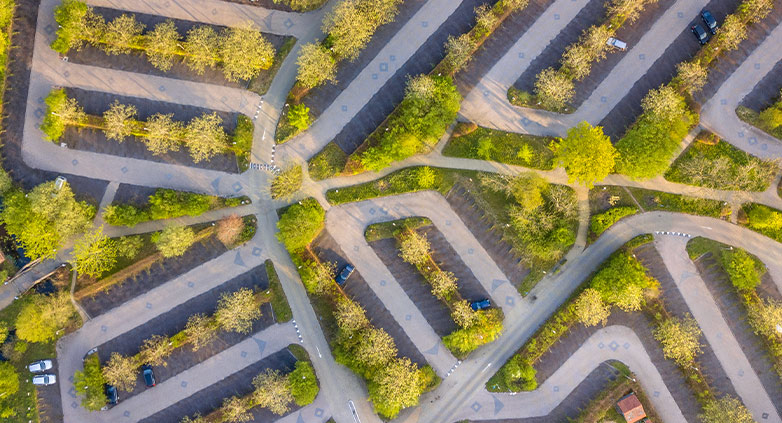Eco-Friendly Parking Lot – 10 Ways to Be Sustainable
In today’s world, as we embrace eco-friendly choices in every aspect of our lives, it’s crucial to consider the construction of eco-friendly parking lots.
Eco-friendly parking lots, using materials like eco-friendly pavers and pervious concrete, help in managing water runoff effectively. These materials allow rainwater to percolate into the ground, reducing flooding and pollution. Such parking lots also contribute to reducing the urban heat island effect, making them an environmentally responsible choice. With thoughtful designs, they offer a practical solution for parking needs while protecting our planet.
Join us as we explore some top eco-friendly parking lot solutions that balance functionality with environmental care.
How Do You Make an Eco-Friendly Parking Lot?
Here are 10 effective strategies to make your parking lot more environmentally conscious and contribute to a greener urban landscape:
1. Use Eco-Friendly Paint
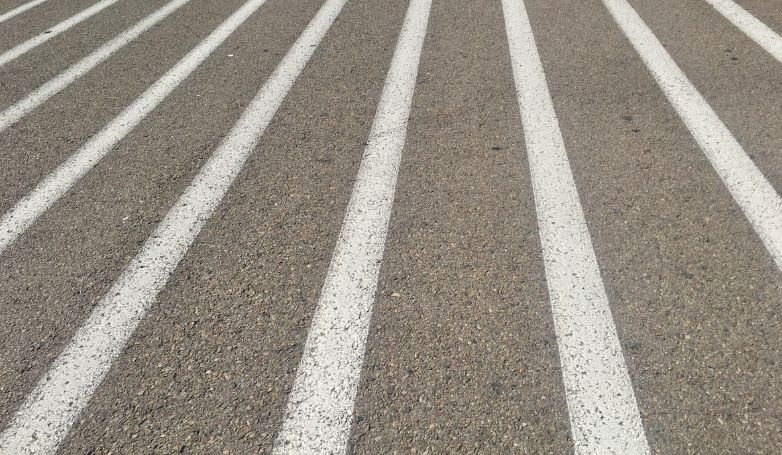
Paint is one of the most common air pollutants. Many types of paint contain Volatile Organic Compounds, such as xylene, toluene hydrocarbons, ammonia, and glycol. These paints are far from eco-friendly and can wreak havoc on the health of humans, animals, and plants.
Consider bio-degradable paints for your parking lot, containing little to no VOCs.
2. Direct Water Runoff
Focus on where the rainwater will go when constructing your parking lot. Water will go its natural course if you don’t, eroding soil, damaging your asphalt, and bringing pollutants. Therefore, it’s a good idea to construct some type of drainage system that directs rainwater to an area that’s appropriate, such as a lake, swamp, or stream.
3. Use Eco-Friendly Pavers
The best solution for an eco-friendly parking lot is permeable locking pavers. These unique pavers allow for water infiltration, unlike your standard asphalt or concrete tarmacking. With these kinds of pavers, you don’t need to worry about flooding nearly as much, as rainwater slowly seeps into the ground to recharge local streams and groundwater supply.
4. Use Pervious Concrete

While not as green as the pavers mentioned above, pervious concrete provides an element of infiltration when well-maintained. Similar to a plastic pavement system, pervious concrete provides natural rainwater filtration and reduces the number of pollutants found in runoff.
5. Plant Grass
Not only do grass parking lots look great, but they are also wonderfully sustainable. Of course, you can’t just plant any only grass, as regular grass attract rut and mud. Instead, we recommend planting plastic pavers to stabilize the grass you plant, thereby improving drainage while keeping your infrastructure intact.
DO NOTE: Grass is best for parking lots with light traffic. Heavy traffic can kill the grass, leaving you with a bare, ugly, and dead parking lot.
6. Plant the Correct Plants

It’s a good idea to plant plants native to your parking lot’s region, as these plants should be well-adapted to the moisture of the soil and the local climate. For example, consider planting trees and shrubs for islands or planting long flower beds or strips atop raised curbing. Not only will this make your parking lot more eco-friendly, but it will also make it far more inviting.
7. Use Recycled Concrete or Asphalt
You can produce an eco-friendly parking lot with recycled concrete and asphalt. The beauty of this process is that it is far less resource-intensive compared to using new materials. In addition, it’s often easy to recycle these materials from old roadways on-site as well, getting rid of the need for environmentally impactful outsourcing.
8. Use a Bio-Based Sealant
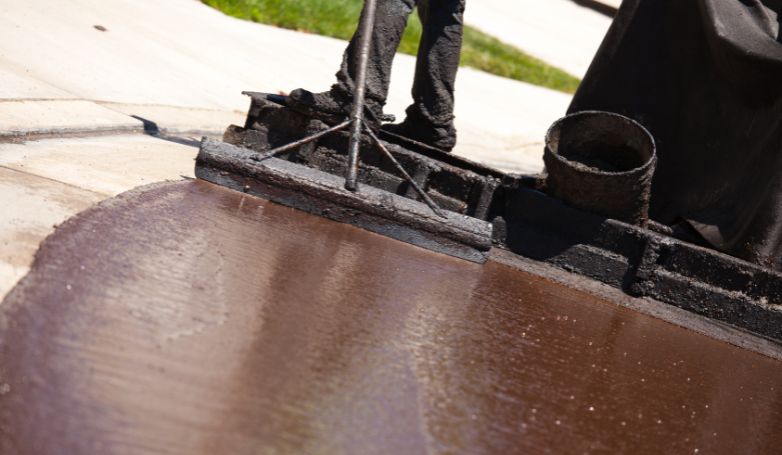
Regular asphalt can take a mighty toll on the environment, which is why it’s a good idea to find ways to make your asphalt as eco-friendly as possible. We recommend finding PAH-free, low-VOC bio-based asphalt sealants. Not only do these work wonders in repairing and resealing surfaces, but they are also much better for the environment than standard products.
9. Maximize Shading
Not only do shade trees and landscaping make for a more aesthetically-pleasing parking lot, but they can also lessen ground heat, enhance air quality, and reduce rainwater runoff. With pervious ground materials and proper shading, you can mitigate the negative impacts of the “urban heat island.”
10. Use Sustainable Lighting
While you should absolutely have lighting in your parking lot to provide safety and security for pedestrians, it’s important that you choose the correct type of lighting to retain energy-efficiency. We often recommend energy-efficient exterior LED lights, as they last a long time (up to 50,000 hours) and have far less impact on energy sources.
You can even implement an efficient lighting layout that maintains higher brightness levels in areas with more traffic while placing other lights in low-traffic areas on a motion system.
Factors to Consider When Creating a Sustainable Parking Lot

Creating a sustainable parking lot involves a careful consideration of various factors to ensure environmental responsibility, long-term cost-effectiveness, and overall functionality. From construction costs to location selection and drainage systems, every aspect plays a crucial role in achieving an eco-friendly and efficient parking facility. In this context, it is imperative to weigh the following key factors
Costs
Modern eco-friendly parking lot construction costs around $69 per square foot, while a simple asphalt paving job costs around $3.85 per square foot. Beyond that, you can expect a few other standard costs for building a sustainable parking lot:
- Operation and Maintenance – $0.15 per square foot
- Drainage System – $45 to $60 per linear foot
- Striping – $346,000 for a 500-vehicle lot
Of course, the main benefit of building an eco-friendly parking lot is that you can reduce your maintenance and energy costs over time.
Location
It’s important to select the right location to build your parking lot, as it can significantly impact cost, safety, durability, and effectiveness. Make sure to consider a few things:
- Accessibility – How easy it is to reach the site
- Topography – The higher ground your parking lot sits on, the better your natural drainage will be
- Quality of Earth – Don’t build on hilly topography or muddy areas
- Soil – Find soil that is dry and compact enough to build on
Drainage and Water Management
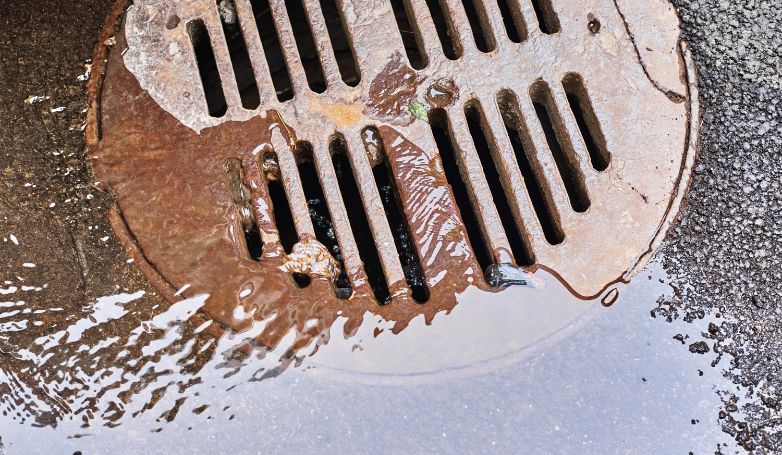
Beyond basic runoff handling, effective drainage systems in eco-friendly parking lots play a vital role in local ecosystems. Permeable paving options like interlocking pavers or porous concrete allow rainwater to seep through, reducing runoff and recharging groundwater.
Bioswales, strategically placed along the lot’s perimeter, use natural vegetation to filter pollutants from the water. Rain gardens, with their deep-root roots, act as natural water filters and habitats for beneficial insects and birds. Advanced systems can even collect and reuse rainwater for landscaping, further conserving water resources.
Materials
When selecting materials, it’s crucial to consider their lifecycle impact. Recycled pavers can be made from post-consumer plastics or rubber, turning waste into valuable resources. Porous asphalt, a mixture of traditional asphalt and aggregate, creates a permeable surface that reduces runoff and improves water quality.
Pervious concrete, with its unique porous structure, allows water to pass through, making it an ideal choice for an eco-friendly parking lot as it prevents the heat island effect often seen in urban areas. These materials not only support environmental goals but can also offer aesthetic variety, enhancing the parking lot’s visual appeal.
Energy Efficiency
Solar-powered lights are a sustainable lighting solution, reducing electricity consumption and greenhouse gas emissions. The integration of electric vehicle (EV) charging stations caters to the growing number of EV drivers, encouraging eco-friendly transportation.
These stations can be powered by solar panels, further enhancing the parking lot’s green credentials. Smart lighting systems, using LEDs and motion sensors, can optimize energy use, illuminating the lot only when needed and thus conserving energy.
Size and Capacity

Balancing size and capacity involves careful planning to meet parking demand without overbuilding. This can include designing multi-level structures to reduce land footprint or using shared parking strategies with nearby facilities to optimize space usage.
The use of space-efficient parking layouts and driving lanes can maximize parking availability while minimizing land disturbance. This approach not only conserves natural habitats but also helps in maintaining the local ecological balance.
Durability and Maintenance
Choosing durable materials for an eco-friendly parking lot reduces the long-term environmental impact by minimizing the frequency of replacements. Long-lasting materials like high-quality concrete or toughened recycled plastics are ideal for eco-friendly parking lots as they require less maintenance, saving resources and reducing maintenance-related emissions.
Innovative coatings and treatments can extend the lifespan of paving materials. Additionally, implementing a regular maintenance schedule helps in early identification of issues, preventing costly overhauls and ensuring the longevity of the parking lot.
Accessibility and Safety
A sustainable parking lot should be universally accessible, with well-designed spaces for differently-abled individuals, including adequate wheelchair ramps and marked parking spaces. Effective lighting ensures safety for both drivers and pedestrians, reducing the risk of accidents.
The layout should facilitate smooth traffic flow to minimize congestion and emissions. Safety features like clear signage, speed bumps, and pedestrian crosswalks enhance the overall functionality and safety of the parking lot.
How Do Parking Lots Affect The Environment?
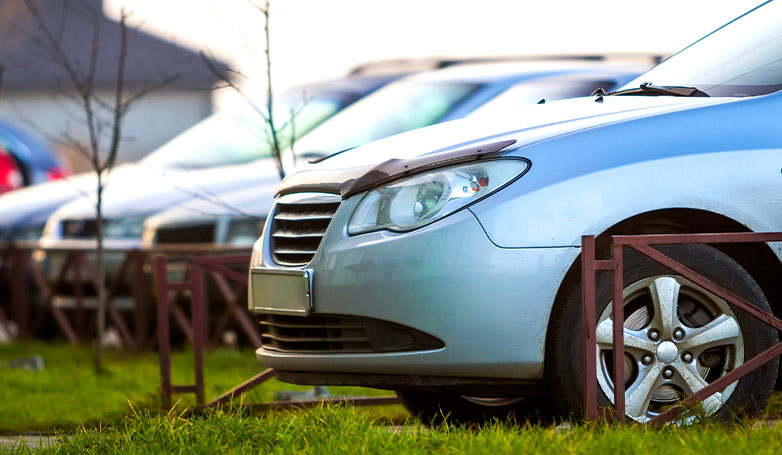
Did you know that the environmental costs of a parking structure can exceed the environmental costs of cars?
Creating and maintaining a parking lot requires a large amount of energy and produces an even greater amount of emissions over the course of its lifetime. Beyond that, parking lots often accumulate pollutants, including grease, oils, sediment, and heavy metals.
When it rains, the water washes these pollutants off into waterways, creating a significant environmental impact.
Furthermore, the more parking lots we have, the less green space we have room to maintain.
FAQs about Eco-Friendly Parking Lot
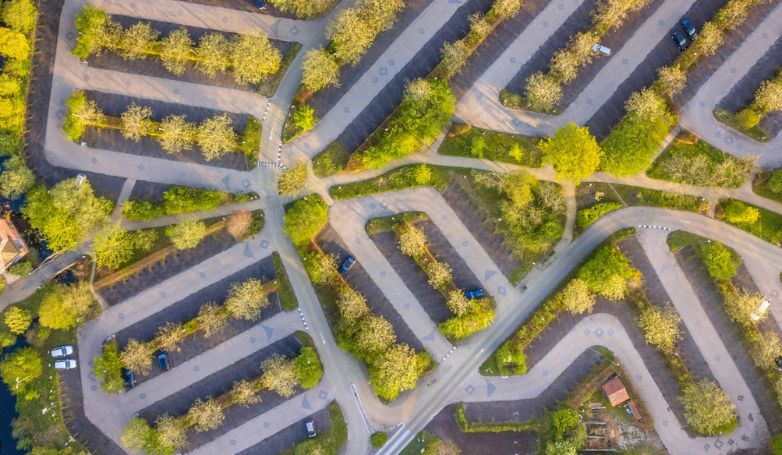
As we delve into the frequently asked questions about eco-friendly parking lots, let’s explore how these green spaces are redefining our approach to urban development and environmental stewardship.
How do you make an efficient parking lot?
To create an efficient parking lot, it’s crucial to optimize the use of space through smart design and layout. Efficiency can be enhanced by incorporating features like LED lighting, solar panels, and efficient drainage systems.
The use of intelligent parking systems that guide drivers to available spaces can reduce the time spent looking for parking, thereby reducing emissions. Additionally, materials like permeable pavement can be used to manage stormwater effectively and minimize environmental impact.
How can I make my parking lot more sustainable?
Making your parking lot more sustainable involves several strategies. Use environmentally friendly materials like recycled pavers or pervious concrete to reduce runoff and heat absorption. Implement green landscaping with native plants to improve air quality and support biodiversity.
Incorporate renewable energy sources, such as solar panels for lighting and electric vehicle charging stations. Regular maintenance and using durable materials also contribute to sustainability by extending the lifespan of the parking lot and reducing the need for frequent repairs.
What is a green parking lot?
A green parking lot refers to a parking area designed with environmental sustainability in mind. Key features include the use of permeable surfaces to allow water infiltration, the incorporation of green spaces, and the integration of renewable energy sources.
These parking lots are designed to minimize their ecological footprint by reducing runoff, improving water quality, and enhancing the urban green space. They often include elements like electric vehicle charging stations, efficient lighting, and materials that are environmentally friendly and durable.
Final Thoughts
With the right amount of research and proper planning, constructing an eco-friendly parking lot can be cost-effective. Environmental protection and conservation start at ground level. YOU can make the change today.

